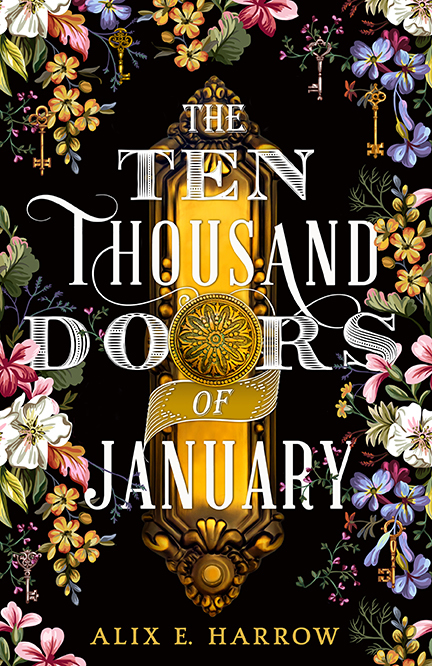The Ten Thousand Doors of January by Alix E. Harrow
- Redhook, 2019
- Kindle ed., 385 pages
- ISBN 978-0-3164-2199-7

I loved this fantasy, a coming-of-age tale based on an epic search for lost love, a place to call home, and the power of stories.
“There’s only one way to run away from your own story, and that’s to sneak into someone else’s” (p. 91).
We first meet the protagonist, January Scaller, at the beginning of the 20th century, when she’s seven years old. She lives with a guardian:
Mr. William Cornelius Locke, self-made not-quite-billionaire, head of W. C. Locke & Co., owner of no less than three stately homes along the Eastern Seaboard, proponent of the virtues of Order and Propriety . . . and chairman of the New England Archaeological Society, a sort of social club for rich, powerful men who were also amateur collectors.
(p. 4)
January’s father, Julian Scaller, works for Mr. Locke. Her father comes home only infrequently, and then for only short periods, before going back out into the world in search of yet more artifacts for Locke’s archaeological collections. Though well educated and provided for, January is a lonely child, not quite at home in the world she lives in:
People are always uncertain about me: my skin is sort of coppery-red, as if it’s covered all over with cedar sawdust, but my eyes are round and light and my clothes are expensive. . . . I was what Mr. Locke called “an in-between sort of thing.”
(p. 6)
In her loneliness she finds solace in stories, particularly writing them: “I wanted to write a different kind of story. A true kind of story, something I could crawl into if only I believed it hard enough” (p. 10). In stories she searches for companionship, love, and a sense of who she is. But Locke keeps reminding her of his expectations for her behavior: “Listen to me very carefully, January. You are a girl of very great potential—immense, even!—but you’ve got to learn to behave yourself. From now on there will be no more fanciful nonsense, or running off, or doors that lead places they shouldn’t. . . . You are going to mind your place and be a good girl” (p. 17).
But, no matter how hard she tries, January can’t resist the pull of stories. As her father has explained to her:
“If we address stories as archaeological sites, and dust through their layers with meticulous care, we find at some level there is always a doorway. A dividing point between here and there, us and them, mundane and magical. It is at the moments when the doors open, when things flow between the worlds, that stories happen.”
(p. 1)
So January begins exploring the world, looking for the doors that will lead to the stories . . . And then, seemingly by magic, she finds a book, “The Ten Thousand Doors: Being a Comparative Study of Passages, Portals, and Entryways in World Mythology.” In this scholarly work she reads:
what is written is what is true. Words and their meanings have weight in the world of matter, shaping and reshaping realities through a most ancient alchemy. Even my own writings—so damnably powerless—may have just enough power to reach the right person and to tell the right truth, and change the nature of things.
Second, my long years of research have taught me that all stories, even the meanest folktales, matter. They are artifacts and palimpsests, riddles and histories. They are the red threads that we may follow out of the labyrinth.
(p. 54)
Fortunately for readers, January doesn’t follow Locke’s demand that she mind her place and be a good girl. With the help of this book within the book, she follows the red threads that lead her out of the world she is so uncomfortable in into her world of love, belonging, and home.
© 2023 by Mary Daniels Brown

